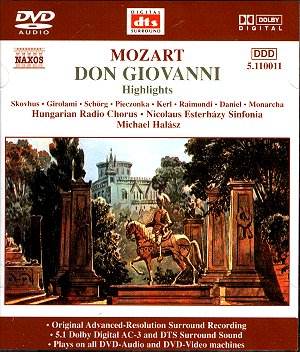Comparison recordings:
Fischer-Dieskau, Stader, Fricsay, Berlin Opera
[ADD] DGG 437 341-2
Siepi, Schwarzkopf, Furtwängler, Vienna
PO [ADD live mono] Gala GL 100.602
‘Il dissoluto punito ossia Il Don Giovanni’ is
on everyone’s shortlist for the prize of Greatest Opera Ever
Written (at least in the ‘between 150 to 240 minutes long’
class). Starting with a traditional straight black-and-white morality
tale, Da Ponte and Mozart worked at adding ambiguities and tempered
every strong emotion with mitigating feelings. It emerged as a
masterpiece study of the complex human emotions surrounding the
ideas of sin, sex, and seduction. Even though he shows no trace
of remorse, we see the Don as a heroic character and admire his
courage even as he falls through the doors of Hell.
The excerpts chosen include the overture and
opening number, and a little under half of the opera, including
most of the famous arias.
The orchestra plays beautifully and the tempi
are well chosen. Skovhus is a magnificent Don Giovanni and has
evidently shaped his role through careful study of many other
artists. He deserves comparison with the very best, including
the great Fischer-Dieskau who is my all-time favourite in the
role. His scream of terror and anguish as he falls into Hell is
the most horrifying sound I’ve ever heard in opera! The rest of
the cast are very good, but not up to the dramatic standard set
by the lead, even though they sing very agreeably. These excerpts
are taken from a complete recording, but appreciated as an assembly
of bits and pieces, the artists err on the side of making beautiful
sounds sacrificing drama as required. For instance, Adrianne Pieczonka’s
Donna Anna is ever the wronged pure maiden, and brings no
anger, spite, or complicated guilt reactions to her characterisation.
Ilkiko Raimondi sings Zerlina beautifully and blends her
voice well with Skovhus in their duet, but sounds too mature,
too wise, for the role, and does not expresses innocence or insouciance,
although absent the preceding recitative, we don’t know what she
might have put into it. Janusz Monarcha as the Commendatore
sings like a stone statue even before he becomes one. The other
artists sing beautifully and everyone blends well in the ensemble
numbers.
Even a brief sampling of the Furtwängler
Salzburg Festival recording cited above will capture you with
the force of its accumulating dramatic tension, making a strong
contrast with this version.
Which brings us to the recording quality. Even
if you own the Furtwängler version you may want to buy this
one for the brilliant high resolution sound which is particularly
welcome during the thick textures of the orchestrally accompanied
ensembles. We have grown accustomed to scrappy high notes and
intermodulation distortion in opera recordings, even on CD opera
recordings, and it is a wonder and delight to hear ‘space’ around
every voice at all times, to hear the artists’ exemplary brilliant
high notes as purely recorded as they are purely sung.
To see how this disk would play in a DVD (video)
player I put it in my new Sony DVD/SACD player which contains
a 96kHz audio chip. There is also a firm notice in the booklet
that it does not (sniff!) play DVD-Audio disks;
one can almost perceive the curl of the lip in contempt. At once
we see on the TV screen a showcard with the title of the track
and a drawing from the set of the opera, and the Dolby stereo
track begins to play. At a new selection, the drawing changes
to one appropriate to the setting. Most buttons have no effect;
pressing the TOP MENU button opens the audio set-up screen where
one is offered the choice of Dolby 5.1 or DTS 5.1 surround. Naturally
choose the DTS if your machine supports it, then back out of the
menu and press enter to play. The perspective is unusually wide
and deep. The sound is fully in the front speakers with ambient
reverberant sounds in the rear speakers. Unfortunately at times
the singers sound like they are engulfed in the set and some distance
away, at other times they are obviously right at the footlights.
But to really appreciate this disk you will want
to hear it on a DVD-Audio player for a further significant enhancement
in the sound quality. For some odd reason my DVD-Audio player
played tracks 10 through 15 as a single track and only advanced
the counter at the beginning of track 16.
For a review of the complete performance from
which these excerpts are taken, see review by
Robert Farr
Paul Shoemaker
